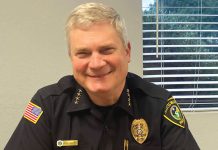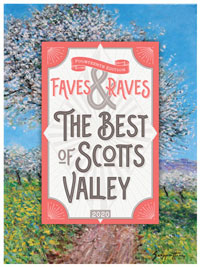At Quail Hollow Ranch in Ben Lomond, I’ve seen the gopher-eating great blue heron and the mountain lion that hides in a small grove of trees across from the pond and takes his deer kill from the nearby fields. But what about the animals who live a life unseen — those who live in the realm of the creepy crawlers, under a rotting branch or in the water?
We’ll uncover the Quail Hollow Ranch’s herps — amphibians and reptiles — in our first watershed walk of the year with Dr. Gage Dayton, the director of the University of California, Santa Cruz Natural Reserves. Details about how to sign up are at the end of this column.
A lifelong vocation
Dayton’s fascination for these misunderstood animals started when he was in kindergarten in San Diego. He shared his path through the chaparral to school with a menagerie of lizards, which he loved to catch and learn about up close.
Dayton studied amphibians in college and then worked on a U.S. Geological Survey on toads and frogs in the Big Bend in Texas.
Then it was back home for the California native for a postdoctoral project in Moss Landing, studying the effects of logging and polluted water on salamanders. Gage worked to mitigate the impact by restoring waterways next to agricultural lands and creating waterways runoff. After the cleanup, the team created habitats for trees, plants, and birds with a buffer.
As the director of UCSC’s five Natural Reserves, he oversees:
– Año Nuevo, the southernmost breeding colony of the Steller sea lion
– Big Creek, a long-term research site studying redwoods and climate change
– Fort Ord, where Gage describes the plants and animals that inhabit the maritime chaparral in this video: http://ucsantacruz.ucnrs.org/?page_id=2230
– UCSC campus, which covers 400 acres of protected lands set aside to preserve natural communities for teaching, field research and natural history interpretation
– Younger Lagoon, a protected lagoon near Long Marine Lab in Santa Cruz
Gage is a popular professor and an engaging field guide. When I caught up with him, he was spending a typical Saturday guiding 30 UCSC alumnae through the college’s preserve in the morning and facilitating an afternoon field-study group of undergraduates, who are studying acorn woodpeckers in the Mount Hamilton area.
The ecology and evolutionary biology students had two days to come up with a project. They chose to research how the woodpeckers’ granary trees disturb the flora and fauna in a valley oaks ecosystem.
During the upcoming walk, we will see a great granary tree specimen at Quail Hollow.
Changes on the horizon
What will nature be like in Santa Cruz County in 50 years?
Gage foresees more development, but taller redwoods, because they were logged more than 100 years ago. He believes residents will continue to have good discussions about smart growth and zoning, which will lead us to preserve more open spaces.
And the walk?
“We’ll be exploring the area for herps with a discussion about their life history,” Gage said. “I’ll be bringing a net to see ‘pond critters.’ Slow, meandering, fun.”
More than 1,900 species of frogs, toads and salamanders — fully 30 percent of the world’s amphibians — are at risk of dying out, according to International Union for Conservation of Nature’s 2011 Red List.
The organization also reported that 664 species of reptiles, more than 20 percent of the total evaluated species, are endangered or vulnerable to extinction.
According to the Center for Biological Diversity, “Cold-blooded animals that spend part of their time on land and part in the water, amphibians are able to breathe through their skin. This permeable skin makes them particularly vulnerable to environmental disturbances, from chemical pollution to the thinning ozone layer and global climate change.”
The Quail Hollow pond was manmade in 1952 for domestic and irrigation use by the owners of the ranch, who also owned Sunset magazine.
Glaciers did not form our land in Santa Cruz County — the sea did. With few natural ponds and lakes, we depend on manmade reservoirs and ponds for water and recreation. Examples include Loch Lomond in Ben Lomond and Antonelli Pond on the west side of Santa Cruz.
Today, the Quail Hollow pond serves as a protectorate for the native western pond turtles whose population has dwindled because of predation by nonnative bullfrogs. Also, owners of pet turtles, such as the much larger red-eared turtle, have dumped their reptiles into local waterways, crowding out native turtles from their habitat.
The 300-acre county-owned park and pond has endured many transformations in recent decades to become as close to a natural state as it has been since Native Americans once roamed this ecologically diverse watershed.
If you would like to join Gage and me on this free walk on May 25, please email me at ca****@*********on.com. The walk is sponsored by an environmental grant from the San Lorenzo Valley Water District.
– Carol Carson, M.Ed., is a nature writer, naturalist and educator.











